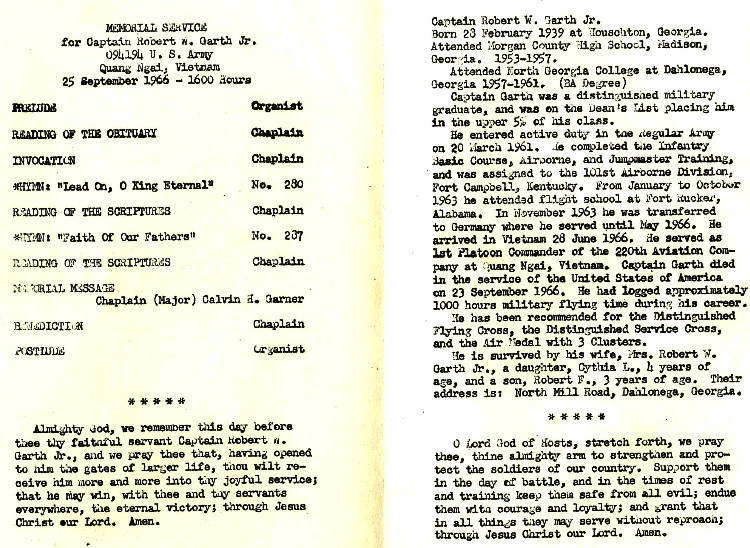CATKILLER HISTORY, 1966:
SIGNIFICANT EVENTS IN THE 220TH RAC, BY DONALD E."Gene" WILSON:
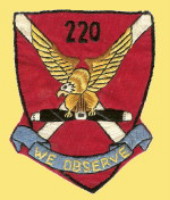
Gene Wilson, Catkiller 5/3, recently wrote a significant historical essay of activities within the unit from June 1966 to June 1967. He is also responsible for a significant increase in roster additions, based on his personal records and recollections, which are supported by his experiences of reviewing many enlisted and officer efficiency reports and flight records. I cannot recall any other document revealing as much as this one — and we salute Gene for his efforts to get this information into its proper place. Gene encourages and we hope that some of these bullet statements might later be expanded by input and additions by others.
Due to another reunion commitment over the same weekend, Gene will not be able to join us in Philadelphia this year. He does wish to send his best regards to all Catkillers at this special occasion. And he does want to be sure that he can purchase a 220th RAC "Catkiller" shirt to show off at the Aerial Rocket Artillery (ARA) Association reunion, which includes his 2nd RVN tour unit, the 2/20th Artillery (ARA), 1st Cavalry Division. Thank you, Gene! (Notice his allegiance and calling to 2-2-0!)
Now for some of the "missing" history (that is the original unit patch above):
1966:
"Most of us replaced originals who had taken the 220th from Fort Lewis, WA to RVN in 1965 — guess that would make us the second team of Catkillers, to be followed by many more — all of whom made their place in Catkiller history.
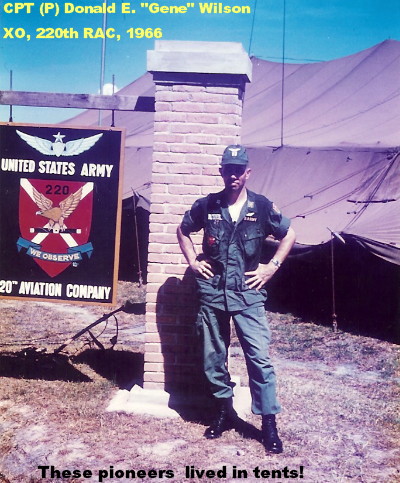
MAJ Bill Schmale, our CO and original XO, had extended his tour in order to command the unit. With his experience from the formation of the 220th at Fort Lewis through the deployment, digging the first foxholes at Phu Bai and weathering the northern Monsoon and the first battle of the Ashau, we were guided well and quickly found our places on the flight lines and in the air.
As soon as MAJ Schmale unshackled me and let me stray a bit from the XO’s desk and the Orderly Room, one of my initial objectives was to visit each of the platoon locations. I quickly learned why the 1st Platoon in Quang Ngai was often called the "Lost" Platoon. I note that 1st Sgt Morrell was always ready to climb in the back seat whenever someone from Phu Bai flew to any of the platoon locations.
- The 2nd Plt and Company Hq were heavily involved with in the 3rd Marine Division in Operation Hastings north of Phu Bai which resulted in being included in the Troop List for the award of the Navy Presidential Unit Citation.
- The 3rd Plt in Danang/Marble Mountain later worked closely with 1st Marine Division in their AO south of Danang and were also included in the Marine Troop List for another award of the Navy Presidential Unit Citation.
- 3rd Marine Division (Fwd) in Phu Bai [based in Danang] soon became HQ 3rd Marine Division at Phu Bai.
We soon traded our MACV shoulder patch for the new 1st Aviation Brigade patch — we were still "in color" then. The totally subdued look did not come until sometime later. There was also somewhat of a time lapse for the "new" jungle fatigues and boots to find their way north of Hai Van Pass.
There was also an "extra" concrete pad poured (or was it just a vacant lot?) on the back right corner that for some reason was not the recipient of a building permit (they must have run out of building materials), but the Marine AOs were able to commandeer a Sea Hut courtesy of the local SeaBees and join in our happy family [Now you know the ‘rest of the story’ of how that odd billet got there.]
- We then moved on paper from the 14th Combat Aviation Battalion headquartered in the Phu Tai valley west of Qui Nhon to the 223rd Combat Aviation Battalion in Nha Trang.
- We lost Bob Garth at Quang Ngai in September.
- We played "musical beds" at the Company Headquarters at Phu Bai as PA & E replaced our weathered GP Medium Tents with the new construction of the cantonment area.
We enjoyed a great Thanksgiving dinner at Phu Bai — which included a formation of Catkillers from Quang Ngai [with a super account in One Day in Viet Nam — A True Story of an Army Bird Dog Pilot by Gary Hook (Lloyd Rugge’s cousin). Our Mess Sergeant, SFC Neal DeNoux, did a fantastic job for the troops. Only a few of us were totally aware of his "deals" in trade with the local SeaBees and the "deliveries" by Air America crews that enjoyed our mess hall on stop-overs.
The Army Chief of Staff, GEN Harold K. Johnson, in his Christmas visit to the RVN, and particularly, his stop at Phu Bai and the 3rd Marine Division, resulted in his flight crew’s use of the Catkiller Hot Spot where he also delayed his departure from Hue/Phu Bai Airport long enough to promote CPT(P) Gene Wilson to MAJ on the Catkiller ramp. [I never saw another Army Chief of Staff (or former one) up real close again until an old friend, John "Shali" Shalikashvili, came back to the Fort Lewis area in his retirement.]
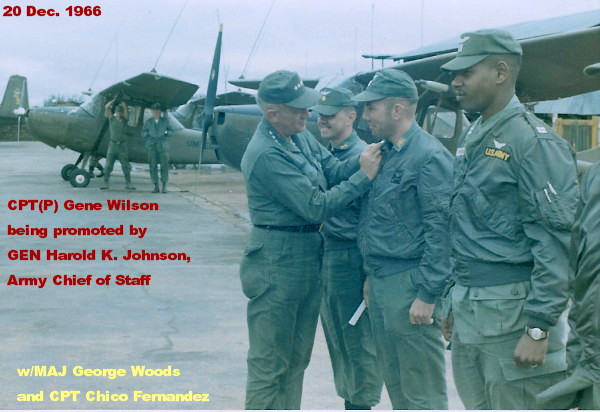
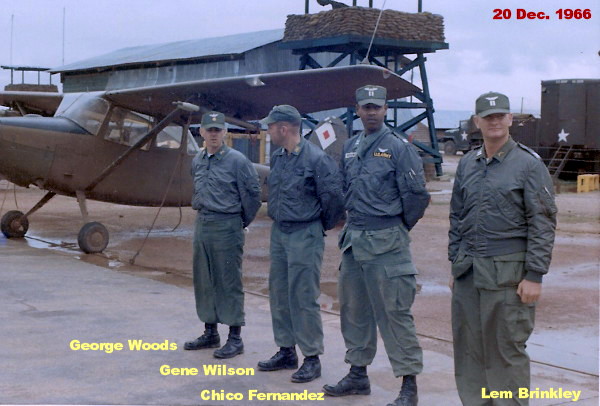
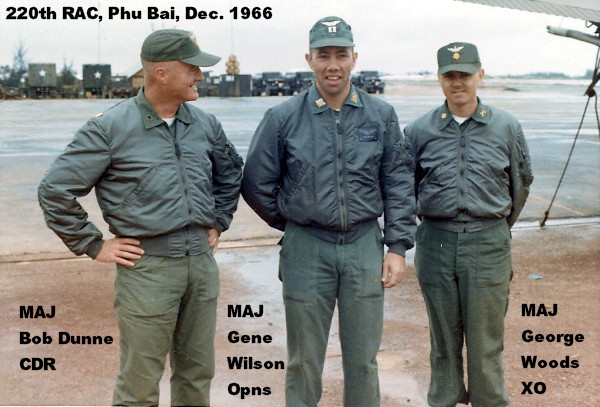
Otherwise, Christmas 1966 was a relatively quiet period with a colorful display of green and red flares from alternate bunkers around the defensive perimeter on Christmas Eve — what a great target designator for the enemy had they been in the mood for an attack — however, they must have been in the holiday spirit too.
While thinking of Santa Claus, is there anyone who has not heard of the exploits of "Catkiller Provider" — then SSG Roger Putnam, our 3rd Plt Sgt at Marble Mountain? What did you need? Roger could find it or had a contact. Only he may remember where and how many Conex containers he had spotted along the coast at airfields. And Roger always seemed to be part of the welcoming committee when anyone stopped over, passed through or spent the night in Danang for whatever reason. He was also well known by the area SF units and a case of chicken or steak was a great passport among them.
SECOND WILSON E-MAIL REGARDING HISTORY:
I went through my box of slides from 1966-67 and had a few prints made. And I also found my maps...I should have remembered that the runway at Phu Bai was East-West and most of our mortar early morning wake-up calls came from the DaNang end of the runway. I am surprised that no one has "checked" me on that. I also bought a copy of A Hundred Feet Over Hell, have read it and reread several portions of it...and the chronicles and events in the lives of many Catkillers of different times could certainly be the basis for a lot of stories between 1965 and 1971. As I recall, Bobbie Johnson, Jim Carlin and I were listening to Dennis O'Connor (about Apr-May 1967), as he was telling us about seeing his first SAM up close — it looked like a "telephone pole" as it passed by him seeking out the tailpipe of a fast mover that he was working with (who had safely evaded it) - up north of the DMZ near Vinh. One of my last missions up that way was in the southern half of the DMZ just to the north of Con Thien and south of the River.
Carl Collins was getting short and wanted to work with some of his Marine Artillery friends one more time before going home. He had been shooting an artillery mission before we got the last minute message on Guard and had to clear out of an Arc Light box by the most expeditious route south ASAP. We made it before the first bombs hit the ground, but our windows did a lot of shuttering before we were sent back in to see if anything had been uncovered. That was the only time that I recall looking at one particular area of the Ben Hai River (accidentally, of course) from the north side at a fairly low level. Right after I arrived in June 1966 I had talked with Woody Woodhurst from the Hue Platoon, who had flown through an Arc Light while it was raining and was still around to talk about it. His only comment — if and when you get caught in the middle of the box with no time to get out, you just take up a heading, cob it and pray.
After Bill Schmale left, George Woods, our new XO, was the only pilot in the Hq who was Otter qualified, until Courtney Smith came in as our new CO, so I got volunteered as co-pilot fairly often. After I left, George earned a DFC when he dead-sticked (yoked) Spud 700 into a SF field strip in the valley to the north of Qui Nhon, under IFR conditions in the clouds from total engine failure to the ground, with only a non-directional beacon and his altimeter under minimal ceiling and visibility — with no damage to the aircraft and barely breaking sweat, so I was told. It might have been exciting to have been with him on that mission, but I never did see George get very excited or rattled about anything — and he was also our Company Birddog IP.
There is not much doubt that Catkillers were a breed apart from the other RACs — and more especially with being in I Corps with the Marines and the Tally-Ho missions. I am glad that I missed the Tet 1968 Offensive, but I was part of the "Cambodian Incursion" with Task Force Shoemaker from the 1st Cav Division that was staged out of Quan Loi on May 1, 1970.
Gene Wilson, Catkiller 5/3
Photographs, 1966—67:
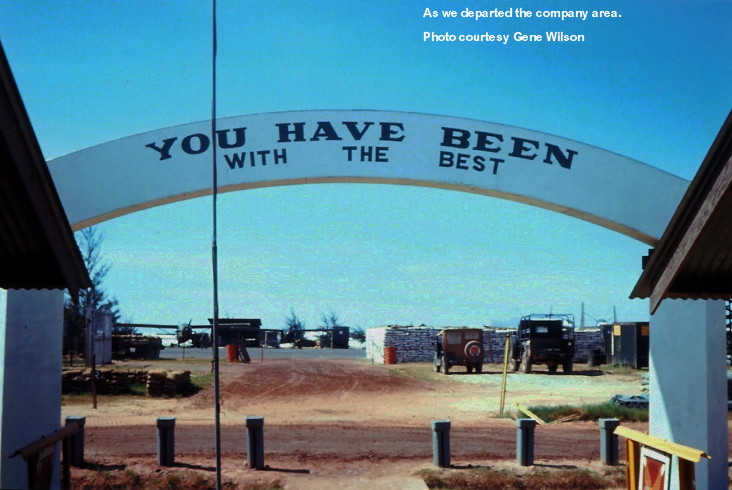
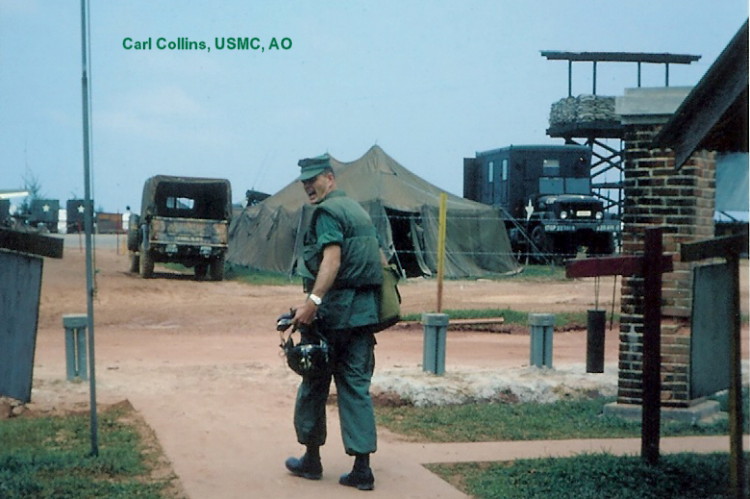
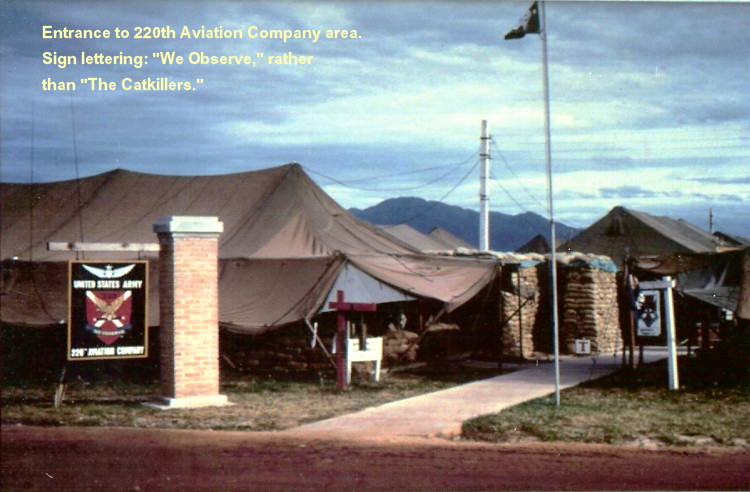
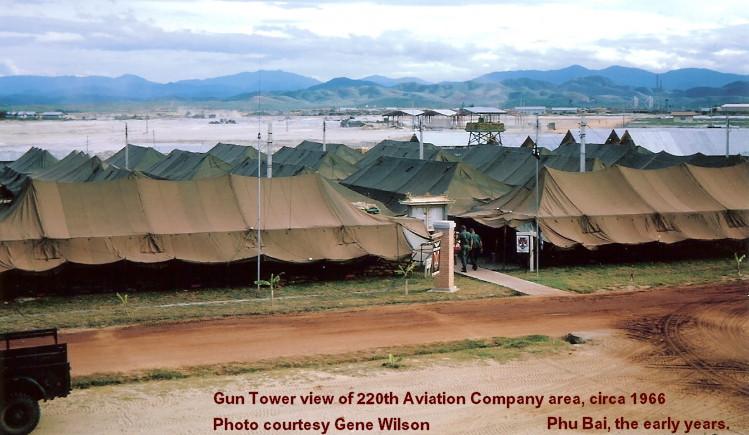
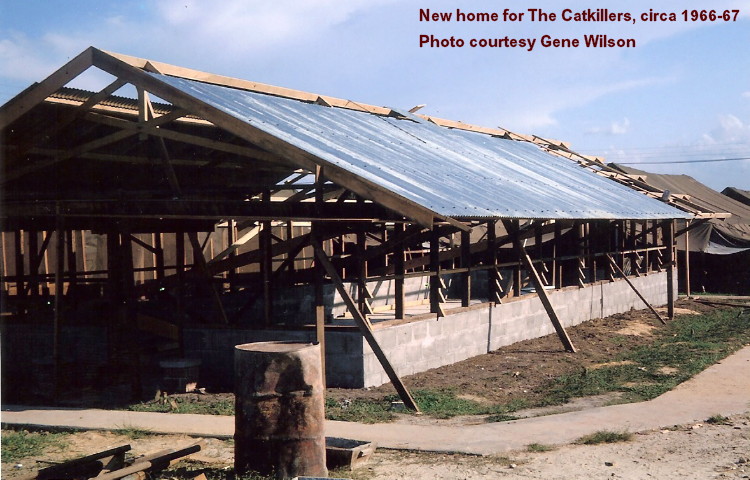
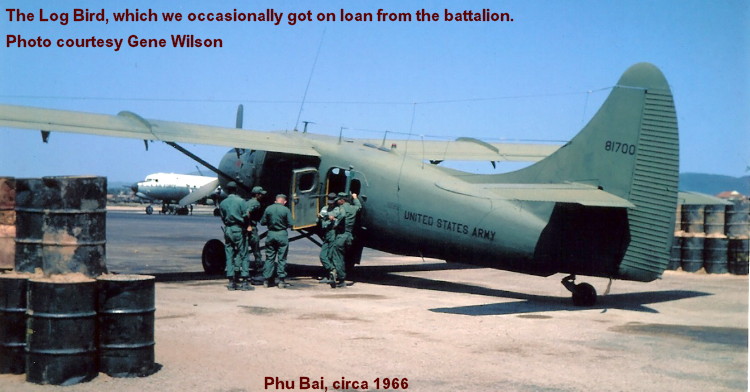
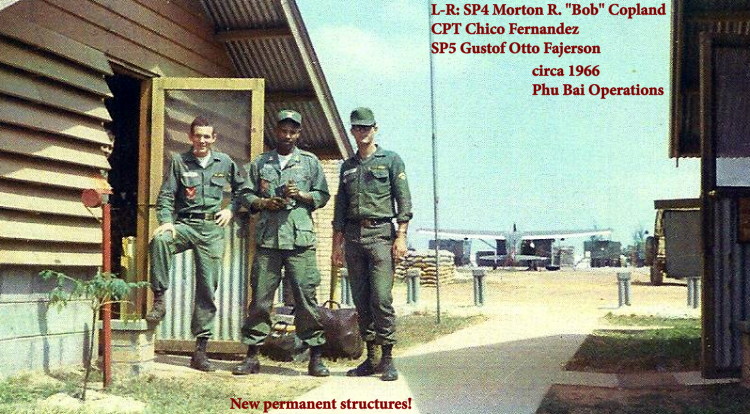
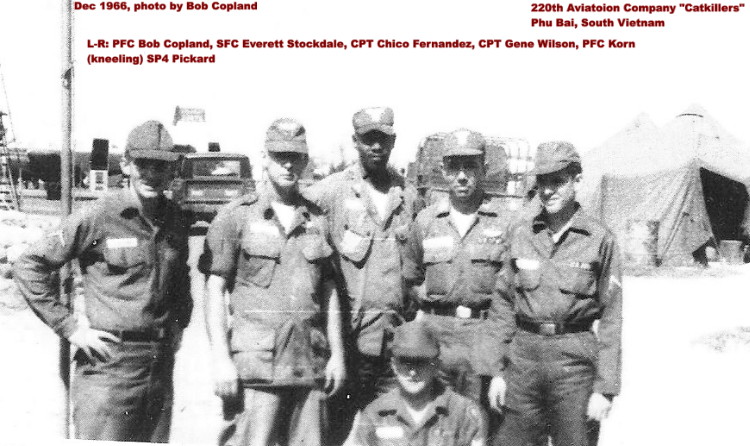
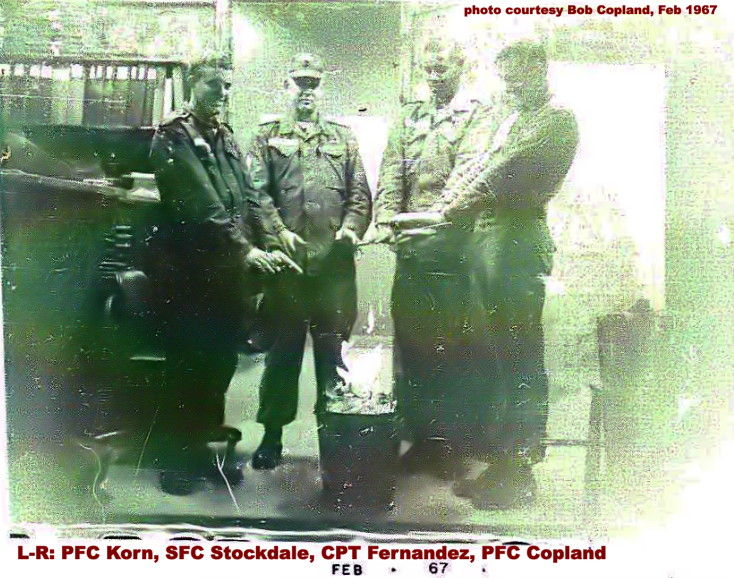
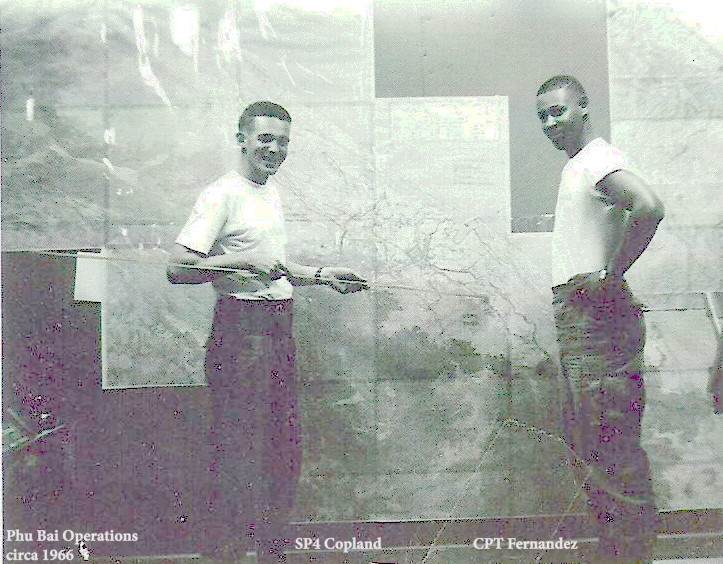
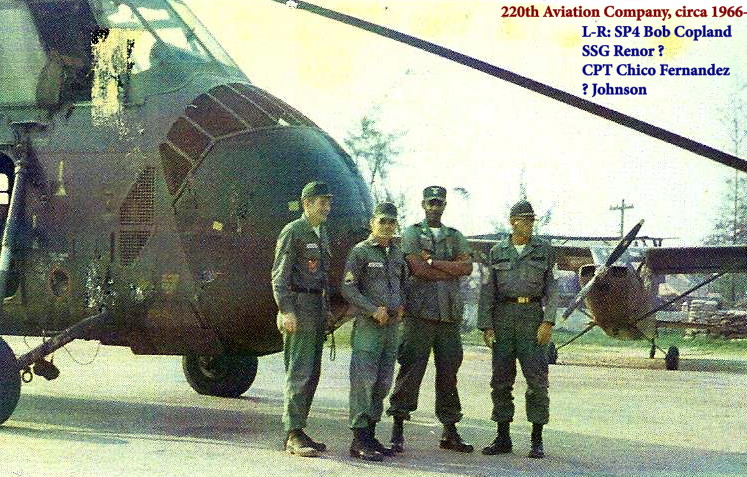
THIRD WILSON E-MAIL REGARDING HISTORY, APRIL 3, 2010:
(Click on photos for a larger image)
The Change of Command slide [below] is a "stray" that must have been given to me by someone because I have no other photos of any kind for that event - but I did write the date on it. Behind me (Commander of Troops) is Palmer Haines, then 2nd Plt Ldr, and to his left is Jim Carlin, then 3rd Plt Ldr. At that time, Dave Antonopolis was the 1st Plt Ldr. I seem to recall that the Platoon Sergeants flew to Phu Bai with their "bosses" but most of the troops in the formation were from Headquarters and Service Platoons so that the flight platoons remained operational. George Woods then came in before the end of the month as our new XO and I was moved into Operations, bumping "Chico" Fernandez to Asst Opns and Joe Davis (then 1LT) to the 3rd Plt in DaNang. Lem Brinkley, from DaNang, had fairly recently replaced Tom Murray as the Supply Officer. "Chico" and I were both senior to all of the platoon leaders at that time and wanted to get "out" to spread our wings; however, we were "retained" due to our 4+ months of "continuity" together. From that changeover and new beginning, there are plenty of stories...but I will sit on those for a while [click on photo for a larger version]:
Sometime in late Summer or early Fall, 3rd MAF went to a "Bone Yard" on Okinawa and literally "put together" a Squadron of O-1Cs (I think there was originally about a dozen of them) shipped them to Vietnam and they were spread out to Chu Lai, DaNang and Phu Bai. They then screened enlisted records to locate any Marine with aircraft or truck mechanic experience to get crew chiefs and somewhat of a maintenance crew at each location. Within about six months — one after another, for a number of reasons, these aircraft were "washed" back out of the Marine air assets. That is when 3rd MAF "investigated" the possibility of having their Marine aviators fly our Birddogs to "help" us get the maximum hours of support possible. Fortunately, I had been promoted by that time and was able to "negotiate" and make an argument, using the demise of their aircraft, and explain how we tried to do our job and maintain our aircraft at the same time. As a very junior MAJ, I actually had some interesting moments with their Air staff.
As I have mentioned before, when I first saw Dong Ha in June 1966, there was not much there — and there was only 3rd Mar Div (Fwd) at Phu Bai. However, by Fall, HQ 3rd Mar Div was in Phu Bai and they opened a Fwd Base at Dong Ha. As I recall, the oiled crushed rock strip was replaced by the PSP strip so that the Air Force and Marine C-130s could (would) land there. This was also about the time that the Air Force "took over" our Army CV-2 "Caribou" and washed it out of the system (a sad story, especially in the support of our area SF outposts). As you can see in the photo, there was not much activity up at Dong Ha among the few tents and transient aircraft. I had gone up as a passenger aboard the CH-46 with the 3rd Mar Div Air Section to "walk" some of the ground with them. And then we actually got tasked with a totally different mission when we got our 4th Platoon back that Spring and sent it Tally Ho. Before I ever flew on a CH-46, Carl Collins advised me to be sure that I saw plenty of evidence of hydraulic fluid and oil, on the deck or anywhere else - otherwise, don't get on it! I can't recall ever seeing very many Marine Hueys up in our area north of Hai Van Pass.
"The Gray Ghost" (below) was a surprise when it was flown in as a replacement for a downed aircraft. When Joe Hamm, our Maint Tech, picked up this “replacement” aircraft somewhere in field maintenance, we wondered where it had come from. It was a pale, primer coat paint job, darker than the Air Force "silver-gray" Birds – looked almost like a primer coat which had been stenciled with black numbers and the ailerons and flaps painted white top–side – and sent on its way because there was no OD paint available at the time. It also did not have all of its radios (notice the single radio antenna above the pilot's head). We kept it as the HQ Phu Bai aircraft for a while and used it for "admin" between platoon locations until we got the OK to paint it “subdued” in our hangar at Phu Bai – installed the proper radios and rocket tubes – and then sent it out to one of the platoons on “duty” status ready to join the fight. Gene
Some of Gene's information and photos will be at history year 1967. DMR
Memorial Service, CPT Robert W. "Bob" Garth Jr., 25 September 1966:
